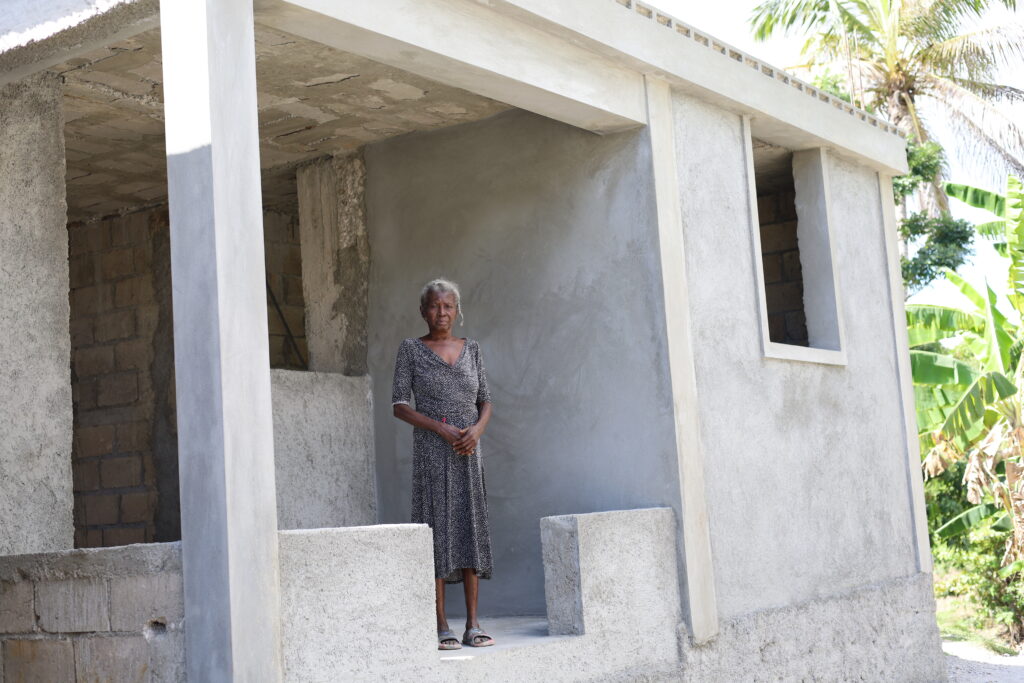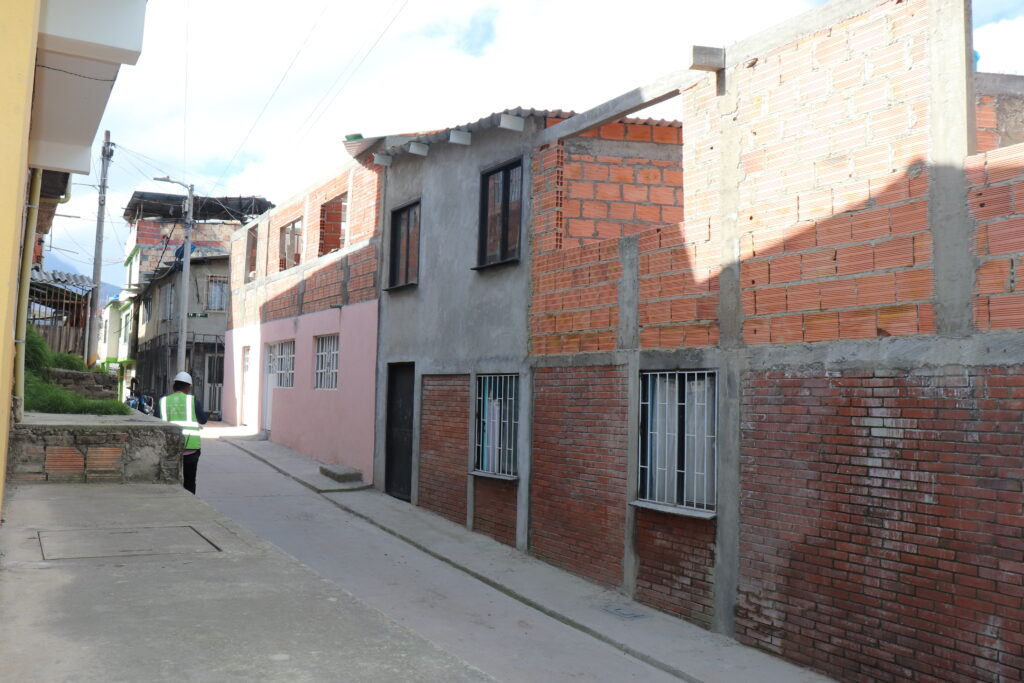Two decades of building resilience: Build Change founder, Elizabeth Hausler on the evolution of climate proof housing
By Elizabeth Hausler, Build Change Founder & CEO | April 24, 2024
In 2001, a devastating earthquake in Gujarat, India, destroying nearly a million homes and killing over 20,000 people, brought to light a critical, often overlooked aspect of disaster recovery: the resilience of our homes. This event not only shattered lives but also exposed the vulnerability of our built environment to natural disasters.
In the wake of this catastrophe, my journey as a civil engineer and a Fulbright Scholar took me to the heart of disaster zones, where I witnessed the stark reality that many reconstructed homes still failed to provide safety and security to their occupants. For instance, many homeowners whose homes had been reconstructed by international non-profit organizations in the aftermath of the 1993 Latur-Killari earthquake still feared for their safety sleeping in their homes nearly 10 years later. This insight led to a resolve: to find a sustainable solution to the man (or woman) made problem of people dying in disasters due to poorly built homes.
In 2004, driven by the belief that homeowners should be at the forefront of the rebuilding process, I founded Build Change. Our mission was clear: to empower local communities to build and rebuild their homes and schools to withstand the tests of nature. Over the past two decades, Build Change has evolved from an idea into a global force, partnering with homeowners, governments, NGOs, finance institutions, local builders, engineers, and materials producers in over 30 countries to enhance traditional building methods, ensuring that they are safe, culturally appropriate, and environmentally sustainable.
Our efforts have yielded transformative results. Since our inception, we’ve made over 1.17 million people and 230,000 buildings safer, preserving approximately $4.7 billion in assets. This has not only saved lives but has also helped communities maintain and increase their wealth. Initially, our work focused on post-disaster scenarios, such as the aftermath of the tsunami in Indonesia and the Sichuan earthquake. However, the devastating 2010 Haiti earthquake marked a pivotal moment for Build Change. It underscored the urgent need to shift our focus from reactive post-disaster building to proactive disaster prevention.

Sylviana Plaisimond standing in new housing in Haiti. Image: Build Change.
In response, we pioneered techniques to retrofit existing buildings, demonstrating that it is both feasible and cost-effective to strengthen buildings in resource-constrained environments before disaster strikes. This shift has become increasingly critical as the frequency and severity of climate-related disasters have escalated.
Today, an estimated 2.8 billion people live in substandard housing vulnerable to these disasters. In response, we have intensified our efforts to retrofit these homes, particularly in densely populated urban areas where the risk of catastrophic loss of life is highest.
Our work in Haiti evolved into a broader strategy to enhance urban housing resilience to earthquakes across the globe. From partnering with local NGOs in China in the wake of the Sichuan earthquake to creating networks of local builders in Haiti, and collaborating with the Colombian Ministry of Housing and the Honduran Red Cross, our global footprint has expanded significantly. In 2023, our reach extended into Africa, with projects in Mozambique, Comoros, and Morocco, reflecting our commitment to regions that are increasingly vulnerable to disasters and climate impacts.
The launch of the Climate Resilient Housing Initiative at COP26 in 2021 was a landmark moment for Build Change. This initiative forged new partnerships across governments, financial institutions, philanthropies, and technological sectors, focusing collective efforts on a singular goal: to build resilience into the fabric of global housing.
Building for longevity
The landscape of resilient housing has undergone transformative changes, reflecting a shift in priorities and practices that emphasize sustainability and safety. For instance, when Build Change first embarked on its mission, the concept of disaster resilience was often sidelined in favour of affordability. It was an uphill battle to convince governments and NGOs of the value in investing a bit more upfront for the safety and longevity of buildings. Today, we’ve witnessed a remarkable evolution in this mindset. More organizations are now prioritizing disaster resilience, integrating it into their planning processes. This paradigm shift from a focus solely on cost to a balanced consideration that includes safety reflects a significant advancement in our collective approach to housing.
Moreover, the range of solutions for housing post-disaster has broadened significantly. The default solution of temporary shelters like tents or temporary camps has given way to more robust approaches involving the quick and efficient construction or retrofitting of permanent housing. This change not only speeds the recovery process but also provides displaced individuals with a quicker return to normalcy and stability.
Perhaps the most profound shift has been the move from top-down approaches in housing reconstruction to models that are driven by homeowners themselves. Influenced by successful programs from Mexico’s Zedillo government and the post-Bhuj earthquake reconstruction in Gujarat, Build Change has championed and helped to popularize the homeowner-driven model. This approach empowers individuals by involving them directly in the recovery process, from design to construction, ensuring that the solutions not only meet safety standards but also resonate culturally and personally with those affected.
Involving local communities has become a cornerstone of our projects. Homeowners are not just recipients of aid; they are active participants from the outset. This empowerment is crucial, as it helps ensure that the solutions we implement are not only technically sound but also embraced by those who live in them. In Colombia, for example, we are developing community-based approaches with the Ministry of Housing to make this model even more effective and far-reaching. By engaging local community-based organizations, we can better understand and leverage existing capacities, enhancing the sustainability and impact of our initiatives.

Building resilient housing in Columbia, August 2022. Image: Build Change.
Addressing the financial challenges associated with constructing resilient homes, especially in under-resourced communities, is a key part of this strategy. Our ‘three-legged stool’ model – engages the people and changes policy (P), facilitates access to financing (M, for money), and implements technology platforms for scale (T). Our partnerships with microfinance institutions have been particularly transformative, enabling low-income families, especially women, to access the necessary funds to strengthen their homes. This approach not only enhances safety but also stability and economic opportunity.
Scaling up
The urgency and scale of the work required to expand resilient housing are monumental, driven by the alarming pace at which the impacts of climate change and natural disasters are escalating. Already, we see that the global situation demands a more aggressive and integrated approach. With Africa’s population expected to reach 3 billion by 2050, and the majority of residential structures yet to be built, the need for safe, resilient housing is more pressing than ever. As we look forward, our commitment is to not only keep pace with this growth but to anticipate and innovate in ways that ensure everyone, regardless of geography or income, has access to safe, sustainable housing.
Build Change’s partnership with the UN’s Race to Resilience initiative has significantly magnified our efforts to boost community resilience on a global scale. Our involvement in the campaign has not only elevated our visibility in international forums like COP27, the World Economic Forum, and various climate weeks but has also anchored our advocacy in a globally recognized framework. This affiliation has led to our inclusion in pivotal agendas, such as the Sharm El-Sheikh Adaptation Agenda, where for the first time a concrete housing-related goal has been set: to reach 3 billion people with safer housing by 2030.
These global advocacy platforms have provided Build Change with unprecedented opportunities to influence policy frameworks and resource allocation, thereby supporting governments and other stakeholders to prioritize resilient housing. This has been particularly evident in our success in Colombia with the adoption of Standard AIS 410 – a milestone policy that provides the technical guidelines necessary to evaluate and mitigate the seismic vulnerability of informally built masonry houses.
Despite these advances, challenges persist. The financial hurdles of securing sustained funding for technical assistance, market development, and systems change are daunting. Moreover, the political landscape often presents a significant barrier to reforming housing policy and releasing funds for resilient housing. These challenges underscore the need for continued advocacy, innovation, and partnership to drive change at the scale required to meet the growing demands imposed by climate change.
Looking forward, I am profoundly hopeful about the future of disaster resilience. This optimism is fueled by the increasing prioritization of climate change adaptation and the em

Elizabeth Hausler. Image: Build Change.
powerment of women in leadership roles, who are making critical decisions about their families’ safety. Our vision extends beyond 2030, with the aim to establish resilient housing as a standalone Sustainable Development Goal (SDG), recognizing its pivotal role in global development.
In the next 20 years, our goal is bold yet critical: to ensure that 20 million people live in disaster-resilient housing. Achieving this will require a unified effort, bridging the gap between local needs and global resources, and transforming the way the world builds. Our journey over the last two decades has set a strong foundation, and with continued support and collaboration, we can expand our impact even further.
As we reflect on the last two decades, it’s the voices of those we’ve helped that echo the loudest, reminding us to keep moving forward. Eusi Raloso, a homeowner from the Philippines, shared: “We lost something – our house – but we got back not only a house, but a chance to work and learn as well.” Similarly, Brinda Timilsina from Nepal expressed: “I no longer have to worry about providing a safe shelter to my grandchildren. They are very happy to live in our retrofitted house, which makes me very happy too. I can’t thank Build Change enough for their technical assistance and support in improving our lives.”
The road ahead is long and filled with challenges, but it is also ripe with opportunities for meaningful change. By leveraging our experiences, partnerships, and the collective will of the global community, we can forge a future where resilient housing is not just a priority but a reality for all.




